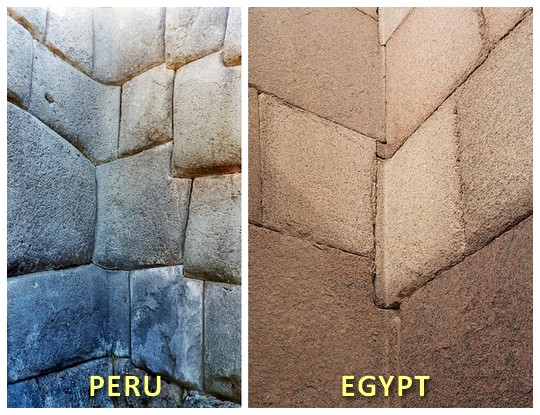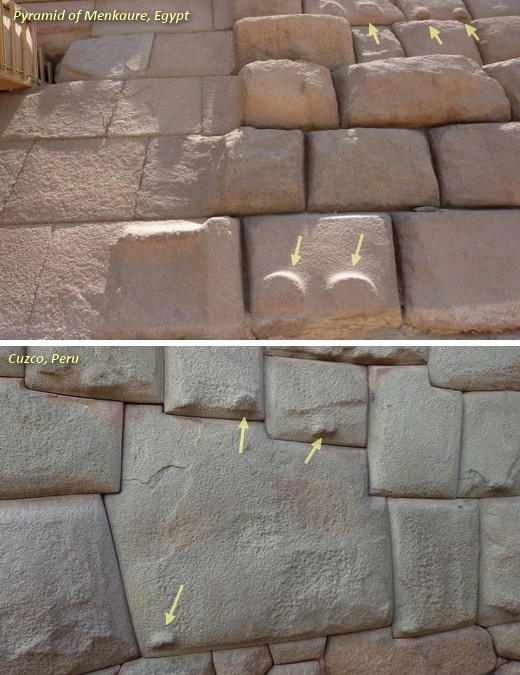It looks like you're using an Ad Blocker.
Please white-list or disable AboveTopSecret.com in your ad-blocking tool.
Thank you.
Some features of ATS will be disabled while you continue to use an ad-blocker.
share:
 According to official archaeological standpoints, there is of course no link or
common ancestry that somehow connects our early megalithic cultures. But is that really true or has something been overlooked? The reason why I ask
are the obvious similarities between some of the early cultures in human history, notably those of the pre-incan and ancient egyptian cultures. Could
there have been some kind of advanced progenitor civilization that influenced some of our earliest known ancient societies?
According to official archaeological standpoints, there is of course no link or
common ancestry that somehow connects our early megalithic cultures. But is that really true or has something been overlooked? The reason why I ask
are the obvious similarities between some of the early cultures in human history, notably those of the pre-incan and ancient egyptian cultures. Could
there have been some kind of advanced progenitor civilization that influenced some of our earliest known ancient societies? In this regard, I came across the following 'common cultural features' on the website of a non-mainstream author called R. Cassaro and found them to correpond to some of my own observations. There have been previous & older threads on this before, but I'd like to revive the discussion in order to see whether or not the general viewpoints may have changed in the meantime.
Here go a few examples of comparisons from his site:
Pyramids

Architecture: Inward Slanting

Metal Clasps

Parallel Solar Symbolism

Elongated Skulls

Trapezoidal Doorways

Antithetical Animal Necklaces

But I'd also like to add another baffling similarity regarding the stonework from my own archive (I think the image on the right in the first set is from hanslune and I assume it's OK to post it here):


IMO, especially the last two examples above are very intriguing, to say the least. Not only did the ancients on both sides of the atlantic work, shape and lift massive mutli-ton megaliths using methods we haven't yet fully understood, but both of these cultures also made walls with stone blocks extending around corners. Also, some of these megaliths feature the same kind of knobs (or protuberances) that look as if they come from inside of the rock.
If we now add in the polygonal walls in Greece and the stonework on Easter Island (Ahu Vinapu) which are also very similar to the pre-incan style masonry, do we not have to ask ourselves if there was an earlier 'global' culture present in those areas which somehow influenced the later societies that settled there? If that was the case, however, we'd have to ask why we haven't found any evidence of said civilization yet (at least 'officially').
A lot of questions arise when thinking about all this and I'm not yet convinced that all this just happened coincidentally. Whatever the case, thanks a lot for reading up to here and I'm very much looking forward to your ideas and thoughts on this ...
Sources & Links:
------------------------------------------------------------
1. Twin Cultures on Opposite Sides of the Atlantic
2. Lost Civilizations of the Andes (1)
3. Lost Civilizations of the Andes (2)
4. Ancient Egyptian Architecture
5. Inca Architecture
6. Incan Vitrified Stones
7. Easter Island (Ahu Vinapu)
edit on 5-6-2014 by jeep3r
because: formatting
I think there is more to the story of early Civilizations than we currently know. There seems to be too many similarities of things to have happened
without some sort of interaction/communication between the earliest of Civilizations.
Awesome post! I've never seen the stones go around corners like that. How would that even be possible with our technology today!? Maybe those knobs
protruding from the rocks were apart of whatever they used to make the walls. But anyways something strange went on back then that no mainstream
archaeologist can explain IMO.
Loved your comparisons! S&F
In Edgar Cayce's book Atlantis, he explains how Atlantis was far more advanced than any other culture. When Atlantis started to break apart, some traveled to distant lands and re-settled. Egypt was one of the three places, but I can't remember the other two.
That might explain the sudden jump in technology for some areas,which seems to have been lost in a very short time frame. Why else would a civilization go from primitive to advanced knowledge overnight, then back to primitive in one generation?
Atlantians supposedly had the ability to travel in the air and under the sea. They could talk to and see people that were far away.( Computer screen?)They had electrical power, based on a large quartz crystal.
If you read the many legendary accounts of Atlantis, you get a picture of a civilization far more advanced than we are today, while the majority of the world was still quite primitive.
In Edgar Cayce's book Atlantis, he explains how Atlantis was far more advanced than any other culture. When Atlantis started to break apart, some traveled to distant lands and re-settled. Egypt was one of the three places, but I can't remember the other two.
That might explain the sudden jump in technology for some areas,which seems to have been lost in a very short time frame. Why else would a civilization go from primitive to advanced knowledge overnight, then back to primitive in one generation?
Atlantians supposedly had the ability to travel in the air and under the sea. They could talk to and see people that were far away.( Computer screen?)They had electrical power, based on a large quartz crystal.
If you read the many legendary accounts of Atlantis, you get a picture of a civilization far more advanced than we are today, while the majority of the world was still quite primitive.
a reply to: nugget1
Much appreciated, nugget1!
Let's assume for a moment that Cayce was (for whatever reason) right with his "clairvoyance", then these atlanteans must have resettled after the cataclysm while perishing at some point, 'prior' to having had contact with the societies that inherited whatever the atlanteans left behind or "rebuilt" on today's megalithic sites.
A very fringe viewpoint, of course, but otherwise we should have found some kind of recorded memories or accounts in AE and pre-incan cultures that tell of these mysterious survivors. Unfortunately, there isn't a trace of such proof. Unless, of course, there's indeed a conspiracy at work and some archaeological finds are, in fact, hidden from the rest of the world. Or, alternatively, some ancient writings or finds have been misinterpreted.
All that is highly speculative, no doubt, but that's something I often wonder about ... there seems to be a missing link somewhere.
Much appreciated, nugget1!
Let's assume for a moment that Cayce was (for whatever reason) right with his "clairvoyance", then these atlanteans must have resettled after the cataclysm while perishing at some point, 'prior' to having had contact with the societies that inherited whatever the atlanteans left behind or "rebuilt" on today's megalithic sites.
A very fringe viewpoint, of course, but otherwise we should have found some kind of recorded memories or accounts in AE and pre-incan cultures that tell of these mysterious survivors. Unfortunately, there isn't a trace of such proof. Unless, of course, there's indeed a conspiracy at work and some archaeological finds are, in fact, hidden from the rest of the world. Or, alternatively, some ancient writings or finds have been misinterpreted.
All that is highly speculative, no doubt, but that's something I often wonder about ... there seems to be a missing link somewhere.
edit on
5-6-2014 by jeep3r because: text
a reply to: jeep3r
My first guess as to who came before... I'm thinking Sumer and Babylon.
They were supposedly a great empire as well not just major cities, like how they are often depicted.
I think it's reasonable to ask/reason that there was a globally connected civilization we don't hear much about in ancient history from the plethora of small clues left behind.
Cheers
My first guess as to who came before... I'm thinking Sumer and Babylon.
They were supposedly a great empire as well not just major cities, like how they are often depicted.
I think it's reasonable to ask/reason that there was a globally connected civilization we don't hear much about in ancient history from the plethora of small clues left behind.
Cheers
If an ancient advanced civilization existed that predates and helped develop all known ones, the key to finding it lies in the oceans of the world. It
is becoming exceedingly unlikely that we will find it on land, unless we find it in Antarctica. But we are talking about a time frame during the last
Ice Age. There was less land covered by water than thanks to all the glaciers and ice. Couple that with humans' tendency to build cities on
shorelines and rivers, and you have a lot of evidence that this early civilization was drowned under the water when the ice melted.
a reply to: Krazysh0t
I've actually also been thinking along those lines for a while, shallow ocean plateaus (today submerged) would be a logical place to look for said remains. The Bimini Road and Yonaguni might be examples for underwater artefacts, provided that further evidence comes to light proving their artificial origin.
Also, Greenland & Antarctica could be candidates for locating a potential progenitor civilization. One might also consider Zealandia as a possible location. Officially a 'sunken continent', which is really interesting, although it is believed to already have submerged about 23 million years ago.
Ultimately, I suppose it's up to all those 'alternative' archaeologists and explorers to try and find hints as to 'if' and 'where' such a civilization may have been around in Earth's history.
I've actually also been thinking along those lines for a while, shallow ocean plateaus (today submerged) would be a logical place to look for said remains. The Bimini Road and Yonaguni might be examples for underwater artefacts, provided that further evidence comes to light proving their artificial origin.
Also, Greenland & Antarctica could be candidates for locating a potential progenitor civilization. One might also consider Zealandia as a possible location. Officially a 'sunken continent', which is really interesting, although it is believed to already have submerged about 23 million years ago.
Ultimately, I suppose it's up to all those 'alternative' archaeologists and explorers to try and find hints as to 'if' and 'where' such a civilization may have been around in Earth's history.
edit on 5-6-2014 by jeep3r because: spelling
a reply to: jeep3r
Either that or land archaeologists and sea archaeologists need to stop splitting up their discipline of study into two separate topics. The world is 3/4ths covered by water, it only makes sense that a good portion of human history is underneath the waves.
Either that or land archaeologists and sea archaeologists need to stop splitting up their discipline of study into two separate topics. The world is 3/4ths covered by water, it only makes sense that a good portion of human history is underneath the waves.
It's highly likely that there existed ancient transcontinental trade routes and contacts. At least there should be an open mind for such possibility.
Antonio, Carlo and Nicolo Zeno are just a part of the puzzle with their mentioned "strange" names and stories. In the times when guilds were in power
and highly likely much earlier, numerous "trade secrets" on purpose were concealed in hopes of gaining supposed advantages and numerous of them were
lost in history.
edit on 5-6-2014 by PonderingSceptic because: (no reason given)
I think the most obvious answer is that a pyramid is the simplest and most stable way to built a high structure. Convergent design.
As for the doorways, its a very simple arch, also a basic predictable step in construction.
As for the jewellery, you could pick a whole slew of random pieces and find a couple that look similar from completely different times and places.
As for the skull shape: skull binding is fairly common You can either wrap around it (which produces the lengthened skulls) or compress with boards which produces a wide foreshortened skull.
No, there isn't any evidence of some older culture connecting the two cultures.
Theorists are generally unfamiliar with the evolution of Egyptian culture. The first farmers arrived in Egypt about 7,000 years ago from Asia (you see Asian crops and animals and ceramics arrive then, which matches the midern DNA studies that show an influx from that area at that time. This population orininally came from the Iran/turkey area. That's where all the oldest crops originate, and its where the very earliest stone buidlings and temples are from (Gobekli). These people also took farming into Europe, forming the Trypillian culture that was the oldest known truly urban population about 7,000 bp, about the same time the first farmers got into Egypt. Prior to the Neolithic, there's nothing but wooden huts and hunter gatherers in the Nile Valley. Construction of the pyramids doesn't start until the Egyptian culture has learned how to make metal tools from asia. This has zero to do with America.
There's no connection between the two.
As for the doorways, its a very simple arch, also a basic predictable step in construction.
As for the jewellery, you could pick a whole slew of random pieces and find a couple that look similar from completely different times and places.
As for the skull shape: skull binding is fairly common You can either wrap around it (which produces the lengthened skulls) or compress with boards which produces a wide foreshortened skull.
No, there isn't any evidence of some older culture connecting the two cultures.
Theorists are generally unfamiliar with the evolution of Egyptian culture. The first farmers arrived in Egypt about 7,000 years ago from Asia (you see Asian crops and animals and ceramics arrive then, which matches the midern DNA studies that show an influx from that area at that time. This population orininally came from the Iran/turkey area. That's where all the oldest crops originate, and its where the very earliest stone buidlings and temples are from (Gobekli). These people also took farming into Europe, forming the Trypillian culture that was the oldest known truly urban population about 7,000 bp, about the same time the first farmers got into Egypt. Prior to the Neolithic, there's nothing but wooden huts and hunter gatherers in the Nile Valley. Construction of the pyramids doesn't start until the Egyptian culture has learned how to make metal tools from asia. This has zero to do with America.
There's no connection between the two.
edit on 5-6-2014 by Antigod because: adding extra facts.
Actually, if any culture could be said to have formed/influenced the Egyptian culture it would be the people who built Gobekli Tepe. I don't think we
even have a name for them. The stone work there goes back to 12,000 bp ish. It's probably the parent culture to every early neolthic culture in North
Africa, West Asia, India and Europe.
gobeklitepe.info...
It also has some influences from the hunter gatherers who lived in the Nile valley when the Asian farmers colonised it, they were lifting big stones into place to mark calender dates and ritually burying cattle, which persisted. They also mummified their dead (Uan Muhuggiag mummy is about 5,500 years old, crudely done).
Egyptian develpoment was all local. I'm less familiar with American.
gobeklitepe.info...
It also has some influences from the hunter gatherers who lived in the Nile valley when the Asian farmers colonised it, they were lifting big stones into place to mark calender dates and ritually burying cattle, which persisted. They also mummified their dead (Uan Muhuggiag mummy is about 5,500 years old, crudely done).
Egyptian develpoment was all local. I'm less familiar with American.
I have no doubt there is a direct lineage to all native cultures from a single point. That point seems to diverge around 6000 BC due to some drastic
change in the way they all understood earth, primarily the deference between wet and dry, than again trying to adapt in new Eco-systems that hadn't
existed before.
Great knowledge was lost (even to them) as evidenced in ancient pyramid building and overall masonry.
The question then becomes, what caused the catastrophic change? How long must we resist obvious historical data because accepting it becomes taboo?
What's more curious is why is the "white race" history not reall predominate until much later in the record?
www.counterpunch.org...
Seems the more we research the more we realize the "white race" appears out of nowhere by some "genetic" mutation 6000 years ago. Coincidently, around the same time a global flood was reported, and shortly thereafter we dominate the globe. Something smells fishy.....
Great knowledge was lost (even to them) as evidenced in ancient pyramid building and overall masonry.
The question then becomes, what caused the catastrophic change? How long must we resist obvious historical data because accepting it becomes taboo?
What's more curious is why is the "white race" history not reall predominate until much later in the record?
The new research supports the theory that the spread of agriculture in Europe beginning (only) around 6,000 years ago favored the survival of people with a genetic mutation producing fair skin. The new grain-based diet lacked Vitamin D, vital to teeth, bone health, and to the immune system. Meanwhile humans inhabiting northern climates received less sun exposure than people in most parts of Africa. Light skin absorbs Vitamin D from the sun much more rapidly than dark skin and so becomes a real advantage from certain latitude, according to the theory.
www.counterpunch.org...
Seems the more we research the more we realize the "white race" appears out of nowhere by some "genetic" mutation 6000 years ago. Coincidently, around the same time a global flood was reported, and shortly thereafter we dominate the globe. Something smells fishy.....
edit on 5-6-2014 by Rosinitiate because: (no reason given)
a reply to: Antigod
There may be no evidence connecting the two cultures. It doesn't mean there were no trade routes or outright direct exchange of crafts, goods. It did happen numerous times in history and similar events numerous times were made accepted historical facts. My guess is that there's no need to list them.
There's a question how there cannot be a connection, as there was constant contact through Inuit–Yupik cultures where rare artifacts and goods could have traveled through Asia. Ethnology has interesting myths from them. There also could have been contacts in other areas and this cannot be excluded.
There may be no evidence connecting the two cultures. It doesn't mean there were no trade routes or outright direct exchange of crafts, goods. It did happen numerous times in history and similar events numerous times were made accepted historical facts. My guess is that there's no need to list them.
There's a question how there cannot be a connection, as there was constant contact through Inuit–Yupik cultures where rare artifacts and goods could have traveled through Asia. Ethnology has interesting myths from them. There also could have been contacts in other areas and this cannot be excluded.
a reply to: jeep3r
I think you are quite right and have always thought we have a chunk of history missing.
The main source of my belief in an ancient civilisation's existence before Sumeria is due to something that has been deliberately ridiculed by the Church, educationists and the elite that its totally overlooked and most people are thoroughly ignorant about it.
Its the Zodiac and who constructed such a clever, sophisticated mathematical mechanism. To do this without computers would have taken thousands of years of observations, meticulous calculations and records etc, a great year takes nearly 25000 years to pass, not to mention the precession of the equinoxes, regression, yet the ancient cultures of the Sumerians, Babylonians, South American cultures, Chinese, Indians etc. all inherited and depended upon it to order their lives and ceremonies etc. A further indication of the zodiac's influence is seen with the Ancient Israelites as their 12 tribes were aligned to the 12 signs and each marched with its Zodiac sign at its head.
We have no records of these civilisations trying to construct their zodiac, they inherited it complete, together with their knowledge of the constellations (from their perspective of the sky) and the planets and most seem to have used Venus in order to measure time via the pendulum. The only real differences were whether they used square or circular wheels, the different animals available to each culture and their personal choices of symbols and whether one uses siderial or tropical perspectives etc. Many zodiacs were used to tell a specific happening and time, especially by the Egyptians.
When one realises that the ancients built their pyramids and buildings aligned incredibly accurately to the cosmos utilising the zodiac this ability and their methods of construction still defy us today.
Its a great pity that Christianity saw fit to deprive the world of the library at Alexandria because perhaps we would have had a far more accurate and better idea of our real past and the peoples long disappeared. However there is a possible clue in the beginning of the bible where it tells us that the world was 'fully populated'. Then it goes on to tell us that God destroyed the world. It further says that he congratulates himself on destroying the people's ability to communicate in the same language. Now whatever one makes of this, it vaguely alludes to an original civilisation that populated the world and spoke the same language. If one then moves to the Indian religious documents they tell us of flying machines, huge wars and bangs and crashes etc. which may or may not verify the biblical account of destruction. If one then goes onto consider people like Case who tell us about Atlantis, corroborated by Plato, we seem still on tract although we also have an earlier myth about Lemuria or Mu, which we can perhaps look to the land mass from Madagasca to India most of which I think has sunk.
When looking at the pictures of the comparison photos above perhaps we are looking at the remnants of that ancient civilisation and the actual people who built such beautiful and magnificent archetecture aligned to the cosmos and its map the zodiac.
I think you are quite right and have always thought we have a chunk of history missing.
The main source of my belief in an ancient civilisation's existence before Sumeria is due to something that has been deliberately ridiculed by the Church, educationists and the elite that its totally overlooked and most people are thoroughly ignorant about it.
Its the Zodiac and who constructed such a clever, sophisticated mathematical mechanism. To do this without computers would have taken thousands of years of observations, meticulous calculations and records etc, a great year takes nearly 25000 years to pass, not to mention the precession of the equinoxes, regression, yet the ancient cultures of the Sumerians, Babylonians, South American cultures, Chinese, Indians etc. all inherited and depended upon it to order their lives and ceremonies etc. A further indication of the zodiac's influence is seen with the Ancient Israelites as their 12 tribes were aligned to the 12 signs and each marched with its Zodiac sign at its head.
We have no records of these civilisations trying to construct their zodiac, they inherited it complete, together with their knowledge of the constellations (from their perspective of the sky) and the planets and most seem to have used Venus in order to measure time via the pendulum. The only real differences were whether they used square or circular wheels, the different animals available to each culture and their personal choices of symbols and whether one uses siderial or tropical perspectives etc. Many zodiacs were used to tell a specific happening and time, especially by the Egyptians.
When one realises that the ancients built their pyramids and buildings aligned incredibly accurately to the cosmos utilising the zodiac this ability and their methods of construction still defy us today.
Its a great pity that Christianity saw fit to deprive the world of the library at Alexandria because perhaps we would have had a far more accurate and better idea of our real past and the peoples long disappeared. However there is a possible clue in the beginning of the bible where it tells us that the world was 'fully populated'. Then it goes on to tell us that God destroyed the world. It further says that he congratulates himself on destroying the people's ability to communicate in the same language. Now whatever one makes of this, it vaguely alludes to an original civilisation that populated the world and spoke the same language. If one then moves to the Indian religious documents they tell us of flying machines, huge wars and bangs and crashes etc. which may or may not verify the biblical account of destruction. If one then goes onto consider people like Case who tell us about Atlantis, corroborated by Plato, we seem still on tract although we also have an earlier myth about Lemuria or Mu, which we can perhaps look to the land mass from Madagasca to India most of which I think has sunk.
When looking at the pictures of the comparison photos above perhaps we are looking at the remnants of that ancient civilisation and the actual people who built such beautiful and magnificent archetecture aligned to the cosmos and its map the zodiac.
originally posted by: Krazysh0t
If an ancient advanced civilization existed that predates and helped develop all known ones, the key to finding it lies in the oceans of the world. It is becoming exceedingly unlikely that we will find it on land, unless we find it in Antarctica. But we are talking about a time frame during the last Ice Age. There was less land covered by water than thanks to all the glaciers and ice. Couple that with humans' tendency to build cities on shorelines and rivers, and you have a lot of evidence that this early civilization was drowned under the water when the ice melted.
Are you familiar with Doggerland?
Doggerland was a former landmass in the southern North Sea that connected Great Britain to mainland Europe during and after the last Ice Age until about 6,500 or 6,200 BCE and then gradually being flooded by rising sea levels. Geological surveys have suggested that it stretched from Britain's east coast to the Netherlands and the western coasts of Germany and Denmark.[2] It was probably a rich habitat with human habitation in the Mesolithic period,[3] although rising sea levels gradually reduced it to low-lying islands before its final abandonment, perhaps following a tsunami caused by the Storegga slide.[4]
Gobekli Tepe is thought to be at least 11,000 years old. The next oldest structures are the megalithic temples on Malta which if I'm not mistake are believed to be about 8,000 years old. I'd bet every dollar I will ever have that there are many submerged megalithic structures at least as old as Gobekli Tepe and probably many that are older.
what if God is a pack of wild aliens and we are due for a flood. AAAAAAAAAh LOL<
how did we get so many different languages? its strange
I guess the aliens decimated our technology to the point where we couldn't travel
at all anymore. time to turn on the flood machine?
how did we get so many different languages? its strange
I guess the aliens decimated our technology to the point where we couldn't travel
at all anymore. time to turn on the flood machine?
edit on 5-6-2014 by nrd101 because: (no reason given)
a reply to: Krazysh0t
Or worse.
We take for granted the stuff we stand on is "solid" ... when in fact, that is contingent upon conditions which can literally change in seconds.
An earthquake is a relatively small (isolated), geographically specific event which, if experienced first-hand, can alter your perspective. The ground beneath your feet can virtually liquefy ... and astonishing things disappear. I do believe the crust of the Earth could 'soften up' enough to displace/subduct an entire continent. We'd probably see some indication (pre-occurrence) at our present level of technological advancement. Back then ... who knows?
As the OP clearly demonstrates ... science, determined by consensus ... isn't science at all. It's guesswork ... not worthy of being even defined as a hypothesis. Professionals know better ... and they leave that to amateurs. In the long run though, it does no one any good.
it only makes sense that a good portion of human history is underneath the waves.
Or worse.
We take for granted the stuff we stand on is "solid" ... when in fact, that is contingent upon conditions which can literally change in seconds.
An earthquake is a relatively small (isolated), geographically specific event which, if experienced first-hand, can alter your perspective. The ground beneath your feet can virtually liquefy ... and astonishing things disappear. I do believe the crust of the Earth could 'soften up' enough to displace/subduct an entire continent. We'd probably see some indication (pre-occurrence) at our present level of technological advancement. Back then ... who knows?
As the OP clearly demonstrates ... science, determined by consensus ... isn't science at all. It's guesswork ... not worthy of being even defined as a hypothesis. Professionals know better ... and they leave that to amateurs. In the long run though, it does no one any good.
I think that there are a lot of very similar things all societies will develop that are similar no matter where they exist. Just like the eye has
developed independently several times and places in nature.
Well, all that copper in Wisconsin went somewhere. I'd have to double check the dates on the mines, but I find it very reasonable that ocean faring
vessels were not wholly uncommon in ancient times. I also find it reasonable that a huge infusion of fresh, cold water into the Atlantic, including
via the Gulf, would wreak havoc on ocean currents. And it could be possible that whirlpools that would make Old Sow look mild by comparison would be
a result.
I think the lack of sea faring peoples from Europe, the Middle East, and Africa is more far fetched. I also think the relationships between concurrent civilizations is sometimes misconstrued. Especially in the America's.
I think the lack of sea faring peoples from Europe, the Middle East, and Africa is more far fetched. I also think the relationships between concurrent civilizations is sometimes misconstrued. Especially in the America's.
new topics
-
Short vs. Long?
General Chit Chat: 14 minutes ago -
Outgoing Lame Duck BIDEN Officials and Democrats Voice Their Regrets.
2024 Elections: 4 hours ago -
Reflections of Elections past
US Political Madness: 6 hours ago -
President Carter has passed
Mainstream News: 9 hours ago -
Get Reday - Here comes the Bird Flu Pandemic - Millions are Notified
Diseases and Pandemics: 9 hours ago -
2 Guys die hunting Bigfoot
Cryptozoology: 9 hours ago -
Joe Rogan and The Black Keys Diorama
General Entertainment: 11 hours ago
top topics
-
Get Reday - Here comes the Bird Flu Pandemic - Millions are Notified
Diseases and Pandemics: 9 hours ago, 16 flags -
President Carter has passed
Mainstream News: 9 hours ago, 15 flags -
2 Guys die hunting Bigfoot
Cryptozoology: 9 hours ago, 6 flags -
Outgoing Lame Duck BIDEN Officials and Democrats Voice Their Regrets.
2024 Elections: 4 hours ago, 6 flags -
Reflections of Elections past
US Political Madness: 6 hours ago, 5 flags -
Joe Rogan and The Black Keys Diorama
General Entertainment: 11 hours ago, 3 flags -
Short vs. Long?
General Chit Chat: 14 minutes ago, 0 flags
active topics
-
Short vs. Long?
General Chit Chat • 0 • : Flyingclaydisk -
Why Such An Uproar Over Non-US Citizens With H1-B Work Visas.
Social Issues and Civil Unrest • 81 • : WeMustCare -
Get Reday - Here comes the Bird Flu Pandemic - Millions are Notified
Diseases and Pandemics • 21 • : FullHeathen -
My personal experiences and understanding of orbs
Aliens and UFOs • 32 • : Compendium -
President Carter has passed
Mainstream News • 13 • : WeMustCare -
Joe Rogan and The Black Keys Diorama
General Entertainment • 6 • : GENERAL EYES -
Outgoing Lame Duck BIDEN Officials and Democrats Voice Their Regrets.
2024 Elections • 6 • : WeMustCare -
Treasury Secretary Janet Yellen Says The USA Will Be in Debt Default in Jan 2025 - Unless...
Mainstream News • 35 • : cherokeetroy -
-@TH3WH17ERABB17- -Q- ---TIME TO SHOW THE WORLD--- -Part- --44--
Dissecting Disinformation • 3846 • : 777Vader -
This is why ALL illegals who live in the US must go
Social Issues and Civil Unrest • 35 • : charlyv
